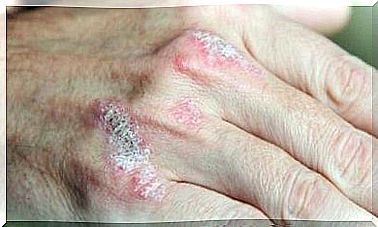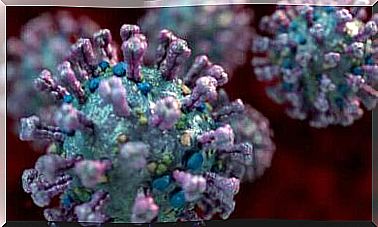All You Need To Know About Cancer Cells
Cancer cells start to form, sometimes up to 30 years before the cancer itself develops. The best way to prevent the onset of this serious disease is to adopt a healthy lifestyle.

Cancer cells have mutations in their DNA – changes that alter the genetic material in each cell. This happens for a variety of reasons, including hereditary factors, bad habits, or exposure to toxic substances.
To date, more than 100 types of cancer have been described. This pathology affects all mammals except a rodent called a naked mole rat. Early detection of the disease significantly improves the prognosis and that is why efforts are focused on monitoring and screening campaigns for its most frequent forms according to age.
What is cancer?
Cancer is a process by which normal cells undergo changes called mutations. As a result, they start to reproduce in an uncontrolled manner. This happens because of a genetic predisposition, but also because of the lifestyle and environment you are exposed to.
In order for the body to function properly, there must be a balance between the birth and death of cells. The body has mechanisms to ensure this balance, but when they fail, this blind cell reproduction occurs which gives rise to neoplasms.

Categorization of cancer according to the type of cell it originates from
According to the cells of origin of cancer, this disease is classified into five groups:
- Carcinoma : When cancer cells are found in the skin or in the superficial areas of internal organs. This is the most common type.
- Sarcoma : if it starts in connective tissue cells, that is, in bones or soft tissues. These include muscles, blood vessels, and other supporting tissues.
- Myeloma : This type of cancer arises from cells in the bone marrow.
- Lymphoma : In this case, cancer cells are lymphocytes, which are part of the immune system.
- Leukemia : occurs when the bone marrow produces an excessive number of immature white blood cells. It is considered to be cancer of the blood.
Differences between normal cells and cancer cells
There are many differences between normal cells and cancer cells. The first is that normal cells stop reproducing when their number is sufficient to perform the function that corresponds to them. Cancer, on the other hand, remains unchecked.
Other important differences are related to cellular interaction. Cancer patients do not respond to signals sent by other tissues, unlike normal cells.
On the other hand, when normal cells are damaged or aged, they repair themselves or die. This would be the expected evolution for the proper functioning and maintenance of functions. Cancer cells break this rule. This explains, in part, the irregular appearance and the increase in the size of the tumor.
When it comes to sticking, normal cells secrete substances that allow them to join another cell group. Cancer cells do not do this, but travel through the body, causing metastasis, that is, forming new tumor sites near or far from the starting area.
So what are tumors?
Tumors are therefore masses formed by the uncontrolled multiplication of a group of cells in any tissue in the body. Just because it’s a tumor doesn’t immediately mean there’s cancer. Here we have to make a difference.
A tumor is benign when its growth is not disproportionate or aggressive. In addition, it does not invade neighboring tissues or metastasize, that is, it does not spread to other organs of the body. In contrast, a tumor is malignant when the mass is made up of cancer cells and can therefore invade nearby tissues and even reach other areas.
What are the stages of cancer?
The process of oncological disease goes from the formation of cancer cells until the cancer reaches its end stage. This can go on for months, years, or even entire decades. The evolution is not always the same and the factors involved are innumerable.
The stages of cancer are as follows:
- Stage 0 : corresponds to the moment when cancerous cells resulting from a mutation appear. This is the longest phase and uncontrolled multiplication occurs there. It doesn’t produce symptoms and is unlikely to be diagnosed.
- Stage I : It is called the in situ phase and the cancerous lesion can already be seen under a microscope. It is possible to make an early diagnosis in some cases.
- Stage II : Cancer cells begin to invade adjacent tissues and this is why we speak of local invasion. In some cases, symptoms are already appearing.
- Metastasis or stage III : The disease spreads and affects areas other than the place of origin and adjacent tissues, for which it is known as distant invasion. There are symptoms that can be serious.
- Stage IV : the terminal phase is that of the progressive and incurable disease. There are severe symptoms, in particular a characteristic severe pain made only bearable by palliative care.
What are the most common treatments?
There are several types of cancer treatments. They are most often used in combination. The medical team assesses the best option, depending on each case and the protocols in force. Each country has developed, in general terms, therapeutic approach guidelines to establish appropriate protocols.
Surgery
It is performed to remove solid tumors. Usually, it is insufficient to eliminate microscopic lesions that may be around the primary lesion. This is why it is common for it to be combined with chemotherapy or radiation therapy later on.
Chemotherapy
It is a treatment that uses the administration of drugs or chemicals to destroy cancer cells. It prevents these tumors from growing and reproducing. However, it can damage healthy cells.
Radiotherapy
Radiation therapy is a procedure that uses X-rays or other types of particles to kill cancer cells. It is also used to reduce the size of tumors.
Other options
Other cancer treatments include immunotherapy, targeted therapy, hormone therapy, and stem cell transplants. Precision medicine helps determine which is best for each particular patient.

Healthy Habits to Prevent Cancer Cells
A healthy lifestyle is the best way to prevent cancer. There are very simple measures that are effective in preventing this dangerous disease from developing. It is best to follow these general guidelines:
- Avoid smoking : Smoking is first and foremost associated with lung cancer.
- Maintain a healthy diet : the inclusion of vegetables has shown beneficial effects.
- Engage in physical activity : on a regular basis.
- Protect yourself from the sun : Skin cancer can develop under the influence of ultraviolet rays.
- Get vaccinated : There are currently immunizations against hepatitis B and human papillomavirus, which prevent cancer of the liver and uterus, respectively.
- Have frequent medical checks : the periodicity of examinations is a simple and inexpensive measure that prevents malignant progression. Mammograms, colonoscopies and uterine cytology have already proven their effectiveness for years.
Cancer cells need to be watched
Cancer changes the lives of those who have it and those around them. The importance of preventing it through personal care, expressed in a healthy lifestyle, should be emphasized.
Science today offers many opportunities to detect this disease early and treat it with a good chance of success. After suffering from cancer, you should also be careful, because there is the possibility that it will reappear, especially in the context of chronic diseases.









